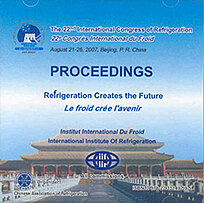
Document IIF
Un matériau innovant d'isolation thermique pour les enveloppes d'immeubles.
An innovative thermal insulation material for building envelopes.
Auteurs : WANG X.
Résumé
CO2 is a substantial greenhouse gas; emissions of CO2 are the greatest contribution to global warming, and buildings are large emitters of CO2. Therefore, energy-saving technology, especially to reduce electricity consumption for air-conditioned (or solely heated) buildings, has been widely investigated. The properties of the building envelope have a strong influence on the thermal performance of buildings (in addition to airtightness of the building envelope), in particular the U-value of their walls/roofs. This paper aims to summarise current developments of state of the art vacuum insulation panels (VIPs), which provide a quantum leap forward in thermal insulation, offering exciting opportunities for both new and retrofitted buildings. Thermal modelling for VIPs and overall effective U-values of walls constructed by VIPs have been carried out. Use of VIPs not only reduces the internal area of buildings but also exhibits excellent performance to meet the requirements of building regulations, as well as offering a great potential to reduce energy consumption for heating, ventilation and air-conditioning systems. The most important consideration in using VIPs is to eliminate cold bridging at the edges and joints between panels in addition to achieving sufficient longevity.
Documents disponibles
Format PDF
Pages : ICR07-E1-849
Disponible
Prix public
20 €
Prix membre*
Gratuit
* meilleur tarif applicable selon le type d'adhésion (voir le détail des avantages des adhésions individuelles et collectives)
Détails
- Titre original : An innovative thermal insulation material for building envelopes.
- Identifiant de la fiche : 2007-2201
- Langues : Anglais
- Source : ICR 2007. Refrigeration Creates the Future. Proceedings of the 22nd IIR International Congress of Refrigeration.
- Date d'édition : 21/08/2007
Liens
Voir d'autres communications du même compte rendu (839)
Voir le compte rendu de la conférence
Indexation
-
Thèmes :
Conditionnement d'air : généralités;
Isolants - Mots-clés : Immeuble; Vide; Matériau; Isolation; Conditionnement d'air
-
How is thermal insulation implemented into prac...
- Auteurs : PAPADOPOULOS A. M.
- Date : 02/12/2009
- Langues : Anglais
- Source : Zbornik radova. 40. Medunarodni kongres o grejanju, hladenju i klimatizaciji./ Proceedings. 40th International congress on HVAC&R.
- Formats : PDF
Voir la fiche
-
Gas-filled panels: a thermally improved buildin...
- Auteurs : GRIFFITH B. T., ARASTEH D.
- Date : 12/1992
- Langues : Anglais
Voir la fiche
-
Dynamic response factor estimation: a point alg...
- Auteurs : IRVING A. D.
- Date : 1992
- Langues : Anglais
- Source : ASHRAE Transactions 1992. Part 2.
Voir la fiche
-
An investigation of common thermal bridges in w...
- Auteurs : MCGOWAN A. G., DESJARLAIS A. O.
- Date : 1997
- Langues : Anglais
- Source : ASHRAE Transactions.
Voir la fiche
-
Space humidity/interior basement wall insulatio...
- Auteurs : GOLDBERG L. F., ALOI T.
- Date : 2002
- Langues : Anglais
- Source : IAQ 2001. Moisture, microbes and health effects: indoor air quality and moisture in buildings [CD-ROM].
Voir la fiche
